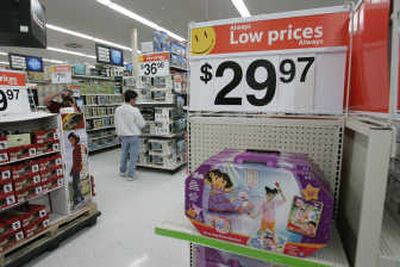Shopper shortage

NEW YORK – The outlook for the holiday shopping season grew bleaker Thursday after retailers announced disappointing October sales results due to consumers’ ongoing worries about housing and higher energy prices.
The downbeat news came from all sectors including mall-based apparel stores like Limited Brands Inc. and department stores like Macy’s Inc. Even upscale Nordstrom Inc. posted a rare sales decline while Wal-Mart Stores Inc., the world’s largest retailer, posted sales below expectations despite its aggressive discounting heading into the holidays.
Warehouse club operators including Costco Wholesale Corp. and BJ’s Wholesale Club Inc. were among the few standouts, a sign that consumers are searching for lower prices.
“Overall, the sales trend continues to slow,” said Ken Perkins, president of RetailMetrics LLC, a research company in Swampscott, Mass. “I think the consumer is certainly feeling the (economic) pressure heading into the holidays.”
Milder than normal weather also hurt sales, wiping out consumers’ appetite for winter wear.
The International Council of Shopping Centers-UBS tally was up 1.6 percent in October, below the original 2.5 percent forecast, marking the slowest October pace since 1995. The tally is based on same-store sales, or sales at stores open at least a year, considered a key indicator of a retailer’s health.
The 1.6 percent pace was below the 2.2 percent gain averaged so far this fiscal year, which for retailers begins in February. Still, Michael P. Niemira, chief economist at ICSC, estimated that mild weather depressed sales results by about 0.75 percentage point.
With Dec. 25 about seven weeks away, the retail industry is struggling with consumers’ eroding confidence and a weakening sales trend amid mounting problems in the economy. Throughout the year, shoppers have been faced with higher gas and food bills and depreciating value of their homes. Tighter credit has also become an issue in recent months.
And while last week’s move by the Federal Reserve to cut a key interest rate by a quarter-point will make it cheaper to borrow money, economists say it may be too late to help boost holiday spending.
Amid such challenges, many stores including Wal-Mart and Toys “R” Us Inc. aim to jump-start the season early this year by offering door busters and big discounts starting last weekend in a season that is expected to show the slowest growth since 2002. But shoppers don’t seem to be in a hurry to buy.
Wal-Mart posted a 0.4 percent gain in same-store sales, below the 1.1 percent gain expected by analysts polled by Thomson Financial. The results excluded fuel sales. Wal-Mart said sales of Halloween merchandise were solid across all departments, but seasonal categories related to cold weather including apparel and home furnishings were weak.
At the company’s Sam’s Club warehouse division, same-store sales rose 2.7 percent, excluding fuel. Including fuel, same-store sales rose 4.2 percent.
Wal-Mart forecast that same-store sales growth will be no more than 2 percent in November. Wal-Mart, which kicked off its holiday discounts with price cuts on toys early last month, promised it will continue to be aggressive in its price cutting throughout the season.
Rival Target Corp., which stumbled in September with disappointing results, fared well in October, posting a 4.1 percent gain in same-store sales, above the 2.5 percent forecast.
Costco had a 9 percent gain in same-store sales, well exceeding the 5.7 percent estimate.
Still, results at the company, which sells gasoline at its warehouse stores, were inflated by an uptick in gas prices in October, from a year ago.
Excluding gas price inflation, sales would have been up 5 percent.
BJ’s said food and gasoline sales drove its same-store sales 4.8 percent higher in October. Analysts had expected a 3.1 percent increase
Among department stores, Nordstrom, which reported a weaker-than-expected 3.2 percent same-store sales gain in September, posted a 2.4 percent drop in October. Analysts expected a 1 percent gain.
Saks Inc., which operates Saks Fifth Avenue, posted a 10.6 percent gain in same-store sales, well exceeding the 5.4 percent estimate.
Macy’s posted a 1.5 percent decline in same-store sales, worse than the 0.6 percent projection.
J.C. Penney Co. had a 1.8 percent decline in same-store sales in its department store business; analysts expected a 0.6 percent increase.
Limited had a 6 percent drop in same-store sales, worse than the 1.6 percent drop Wall Street expected.